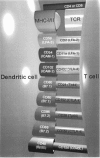Dendritic cells: immunological sentinels with a central role in health and disease
- PMID: 10762408
- PMCID: PMC7159383
- DOI: 10.1046/j.1440-1711.2000.00888.x
Dendritic cells: immunological sentinels with a central role in health and disease
Abstract
Immunological effector cells must be sensitive to the antigens or environmental signals that indicate that a pathogen is present. To this end, a group of cells known as the professional antigen-presenting cells have the ability to educate T, B and NK cells as to the fingerprints of specific infections. The most adept of these cells are a closely related family termed dendritic cells (DC). A subset of these act as peripheral sentinels, specializing in the uptake, processing and presentation of antigenic material combined with an ability to detect a wide variety of 'danger' signals. These 'danger' or activation signals induce profound changes in dendritic cell physiology, facilitating the efficient stimulation of both adaptive and innate immunity. In the present review, a number of recent advances in the understanding of DC biology are discussed. These advances offer insights into the pathogenesis of a wide variety of diseases and point towards future strategies for immunotherapy.
Figures



Similar articles
-
Dendritic type, accessory cells within the mammalian thymic microenvironment. Antigen presentation in the dendritic neuro-endocrine-immune cellular network.In Vivo. 1997 Jul-Aug;11(4):351-70. In Vivo. 1997. PMID: 9292303
-
Dendritic cell subsets.Semin Cell Dev Biol. 2018 Dec;84:11-21. doi: 10.1016/j.semcdb.2017.12.009. Epub 2017 Dec 23. Semin Cell Dev Biol. 2018. PMID: 29246859 Review.
-
Ins and outs of dendritic cells.Int Arch Allergy Immunol. 2006;140(1):53-72. doi: 10.1159/000092002. Epub 2006 Mar 13. Int Arch Allergy Immunol. 2006. PMID: 16534219 Review.
-
Dendritic cells as gatekeepers of tolerance.Semin Immunopathol. 2017 Feb;39(2):153-163. doi: 10.1007/s00281-016-0583-z. Epub 2016 Jul 25. Semin Immunopathol. 2017. PMID: 27456849 Review.
-
Dendritic cells from bench to bedside and back.Immunol Lett. 2009 Feb 21;122(2):128-30. doi: 10.1016/j.imlet.2008.11.017. Epub 2008 Dec 31. Immunol Lett. 2009. PMID: 19121337 Review.
Cited by
-
Vaccine and immune cell therapy in non-small cell lung cancer.J Thorac Dis. 2018 May;10(Suppl 13):S1602-S1614. doi: 10.21037/jtd.2018.05.134. J Thorac Dis. 2018. PMID: 29951309 Free PMC article. Review.
-
Functional Impairment of Mononuclear Phagocyte System by the Human Respiratory Syncytial Virus.Front Immunol. 2017 Nov 27;8:1643. doi: 10.3389/fimmu.2017.01643. eCollection 2017. Front Immunol. 2017. PMID: 29230219 Free PMC article. Review.
-
Increased serum transforming growth factor-beta1 in human colorectal cancer correlates with reduced circulating dendritic cells and increased colonic Langerhans cell infiltration.Clin Exp Immunol. 2003 Nov;134(2):270-8. doi: 10.1046/j.1365-2249.2003.02295.x. Clin Exp Immunol. 2003. PMID: 14616787 Free PMC article.
-
Results of a phase 1 study utilizing monocyte-derived dendritic cells pulsed with tumor RNA in children and young adults with brain cancer.Neuro Oncol. 2004 Jul;6(3):236-46. doi: 10.1215/S1152851703000668. Neuro Oncol. 2004. PMID: 15279716 Free PMC article. Clinical Trial.
-
Vitamin E and selenium improve mesenchymal stem cell conditioned media immunomodulatory effects.Stem Cell Investig. 2021 May 7;8:9. doi: 10.21037/sci-2020-008. eCollection 2021. Stem Cell Investig. 2021. PMID: 34124232 Free PMC article.
References
-
- Banchereau J, Steinman RM. Dendritic cells and the control of immunity. Nature 1998; 392: 245–52. - PubMed
Publication types
MeSH terms
LinkOut - more resources
Full Text Sources
Other Literature Sources

